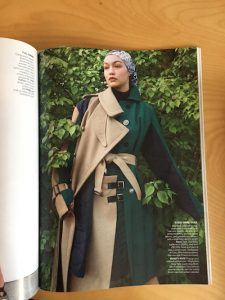by Joan Harvey

Even though I knew better, when I was told I could get free magazine subscriptions with my minimal airline miles that would otherwise expire, I succumbed. Of course I didn’t need any more reading material, and I was fully aware of the waste they’d create, but I allowed myself to be lured by the idea that getting something was better than getting nothing. So I got Food and Wine, with recipes that I could never make, and Conde Nast Traveler, with glamorous photos of places I’ll never go. And I got Vogue, with, naturally, clothes I will never wear. I’ve always enjoyed fashion. But I found the first issue I received, August, disturbing. I was astonished at how covered up all the models were. Almost no skin anywhere. Necklines were high, so high that there were turtlenecks even on summer dresses. Turtlenecks even on the beach. Long coats over full length body suits on the beach. Gigi Hadid, of Dutch and Palestinian heritage (I suppose to avoid issues of cultural appropriation) is shown in a head scarf and a coat the same green as the sister wives in The Handmaid’s Tale. And, naturally, she too is wearing a turtleneck. There are also almost no legs to be seen in the issue. Dresses are shapeless and long. Even bare arms are rare. Hair is cut short or covered up. The September Vogue was not much different. More long dresses, more head scarves, more turtlenecks on the beach. Though in this issue we do get some shots of Beyoncé’s legs.
An article in the September Vogue by Lynne Yaeger asks: “Is there seduction in concealment?” The models in the photos accompanying her essay have not just their bodies, but their faces covered as well. “What is the meaning of this peekaboo?” Yaeger writes. “Is this desire to cover up— which manifested itself in the all 2018 collections not just with covered heads but with modest necklines and voluminous long sleeves—a reflection of the #MeToo moment, a rage against the sexual-objectification machine? . . . Or perhaps the new visibility of women in the Middle East, and they way that hijabs are finding their way into the fashion vocabulary, is playing a role? Or could it just be that in an age of Instagram vainglory the allure of literally covering up, of not being so endlessly available, has its own currency?”[1] Read more »
